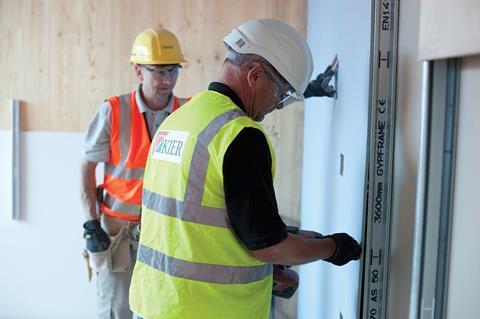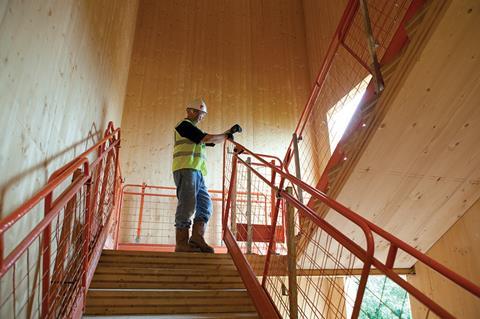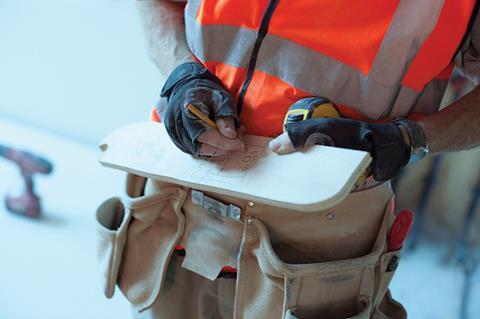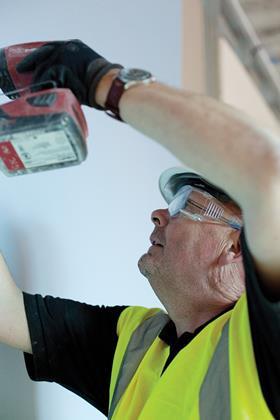Are construction bosses any good at building? Kier MD Graham Howe volunteered to spend time on site to find out

The gap between the people who run the nationŌĆÖs biggest companies and those at the coalface has never been greater. While once an industrious employee could start at the bottom and climb right to the top, todayŌĆÖs boardrooms are increasingly stuffed with people who started their careers with MBAs under their belts and a distinct lack of oil under their fingernails.
With this in mind, ║├╔½Ž╚╔·TV decided to find out whether it was possible to reconnect the manager with the workers on the ground, by asking a senior executive to do a few hoursŌĆÖ work on a busy building site. Would they learn more about their business? And would the site workers welcome the presence of a not-so-undercover boss?
Of those companies asked, Kier seemed by far the most keen to give the experiment a try. Graham Howe, managing director for its eastern region, volunteered to spend a day working on site in Norwich, on a teaching facility the contractor is building for the University of East Anglia (UEA). Howe was, KierŌĆÖs PR said, ŌĆ£up for itŌĆØ and looking forward to the experience. So, how did he get on?

A model project
NorwichŌĆÖs most famous fictional son, Alan Partridge, may be one cultural influence putting the city on the map in recent weeks with his film premier, but it is one of the East Anglian cityŌĆÖs real-life historical giants that provides the inspiration for the building Howe is to help build. While the structure is currently known as ║├╔½Ž╚╔·TV 57, when open it will be named the Julian Study Centre, a reference to Julian of Norwich, a 14th-century female city resident, who apparently experienced a series of visions of Christ. Her account of her experiences is believed to be the oldest surviving text in the English language written by a woman.
ItŌĆÖs an unusual project. I want to get a better feel for how the components come together [and] I knew Adrian wouldnŌĆÖt drop me in it
Graham Howe, Kier
Marrying historical allusion with contemporary concerns, the Julian Study Centre is intended to be a model of sustainable design. The buildingŌĆÖs structure, erected in just eight weeks, is made from cross-laminate timber - the 12th project HoweŌĆÖs division of Kier has built using the material. More unusually - Kier says it is a first in the UK - each floor is divided by TermoDeck concrete, which allows passive cooling of the building in summer. In the winter, says project manager Adrian Cooper, the entire four-storey building will be heated by just two domestic boilers. In short, it will be the greenest building on the UEAŌĆÖs substantial campus.
ŌĆ£ItŌĆÖs an unusual project,ŌĆØ Howe says, and one he was keen to see up close. ŌĆ£I wanted to get a better feel for how the components come together. IŌĆÖve also worked with Adrian for many years and I knew he wouldnŌĆÖt drop me in it too badly, although heŌĆÖs had a go.ŌĆØ

On site
It is 1.30pm and, while ║├╔½Ž╚╔·TV has just arrived on site, it turns out that Howe has been in situ since 7.30am. While itŌĆÖs hardly a secret that construction workers and journalists keep rather different hours, this comes as a surprise. After all, we had only asked Howe to give up an afternoon. To have already put in six hours, albeit with breaks to keep up with his emails, Howe had gone above and beyond the call of duty. ŌĆ£IŌĆÖve been working with the plasterboarders and dryliners all morning,ŌĆØ he says. ŌĆ£IŌĆÖve learned quite a lot about health and safety and how complicated and manual a lot of the jobs are. Ever since I graduated, my mantra has been, ŌĆśdonŌĆÖt ask people to do something you wouldnŌĆÖt try to do yourselfŌĆÖ. You need to understand exactly what it is youŌĆÖre asking people to do.ŌĆØ
But enough of the morning - itŌĆÖs time to see how Howe performs in the media spotlight, so we boot up and don high-visibility vests, hard-hats and goggles.
First up is a return to installing plasterboard, where Howe is placed under the direction of Dean Sutton, the foreman from subcontractor Great Yarmouth Ceilings, a specialist in drylining and ceiling installation. As Howe cuts the board neatly and efficiently and handles a power drill with ease, it soon becomes clear that this is an executive who doesnŌĆÖt mind getting his hands dirty.
ŌĆ£Graham is very hands on,ŌĆØ says Sutton. ŌĆ£HeŌĆÖs really willing to try things.ŌĆØ
ŌĆ£I think I may have set the programme back by two weeks,ŌĆØ says Howe, with a self-deprecating smile. ŌĆ£IŌĆÖm not going to give up the day job.ŌĆØ

Mucking in
In fact, this is not the first time Howe has got his hands dirty. He used to work as a labourer on construction sites when he was at college, before going on to do an engineering degree at Brunel, and rising through the ranks at Kier and gaining a directorship at Willmott Dixon at the age of 32. He re-joined Kier in the mid-noughties, rising to his current position about eight years ago.
Having a managerial position inevitably ties Howe to an office most of the time, though he has tried to keep up his interest in the practical side of the building trade, albeit in a domestic environment. ŌĆ£Now weŌĆÖre in a nine-month-old house, but we had a 250-year-old house before and it needed a lot of work,ŌĆØ he says. ŌĆ£I tend to get people in to do the work now that IŌĆÖve got older, but I used to do everything myself. When youŌĆÖre in the trade, you canŌĆÖt help but see stuff that needs doing.ŌĆØ
At this point Cooper announces that itŌĆÖs time for Howe to move on to his next task. ŌĆ£WeŌĆÖre going to do some plumbing now,ŌĆØ he says, before hesitating. ŌĆ£I mean plumbing in its loosest sense - we donŌĆÖt want any leaks.ŌĆØ We move up a floor and Howe is placed under the tutelage of subbie Sean Clifford.
As Howe saws steel and builds up quite a collection of pipe brackets, the pair chat away like a couple of old mates. Clifford examines the work, as Howe downs tools. ŌĆ£ItŌĆÖs all been done to a very good standard,ŌĆØ he pronounces.
With that, the day is over, and Howe offers us a lift back to Norwich station in his Mercedes, still dressed in paint-splattered work jeans and a company branded polo-shirt. ŌĆ£The most important thing about what IŌĆÖve done today is understanding how hard it is for those guys to meet the standards we set,ŌĆØ he says on the way. ŌĆ£ItŌĆÖs been really good.ŌĆØ
So Howe has benefited from his day on site - but what did his fellow workers think? Reflecting on the day 48 hours later, Cooper praises HoweŌĆÖs performance and says he gained the respect of the workers. ŌĆ£The feedback I got from the guys was that he was keen to do what he was asked to do. He didnŌĆÖt refuse to do anything and did it in a competent manner.ŌĆØ
Cooper also believes that HoweŌĆÖs day on site did a lot to persuade subbies that their management understood the challenges asked of them. ŌĆ£They were impressed by the fact that a director could see the difficulties they have on site,ŌĆØ he says. ŌĆ£A manager can just sit in their office, divorced from the actual workings on site. ItŌĆÖs not that [this experience] will change anything, but it did open his eyes to what people have to put up with on site.ŌĆØ
Given the mutual appreciation when management engages with tradespeople, perhaps it is something that should be encouraged more widely.




























No comments yet